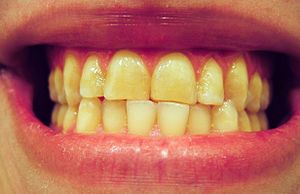Bruxism
Bruxism is the problem of too much tooth grinding or jaw clenching.[1] It is not a normal use for teeth like eating or talking.[1] he global bruxism (sleep and awake) prevalence is 22.22%. The global sleep bruxism prevalence is 21% and awake prevalence is 23%.[2] Bruxism can wear down teeth, make them too sensitive, and cause headaches and jaw pain. It can also harm dental work like crowns and fillings.[3] Sometimes these problems are not noticed, so not everyone with bruxism knows they have it.
| Bruxism | |
|---|---|
 | |
| Attrition (tooth wear caused by tooth-to-tooth contact) can be a manifestation of bruxism. | |
| Medical specialty | Dentistry, Psychiatry |
There are two main kinds of bruxism: sleep bruxism and awake bruxism. Sleep bruxism happens when the person sleeps, and awake bruxism happens when the person is awake. Symptoms of sleep bruxism are often worse when waking up. Awake bruxism can feel fine when waking up, then get worse as the day goes on. There may be many reasons why people grind their teeth and clench their jaws.[4][5] Awake bruxism may have different causes from sleep bruxism. Females are more likely to have awake bruxism. Sleep bruxism affects males as often as females.[5] Several treatments are used, but none are proved to be very effective.[6]
References
change- ↑ 1.0 1.1 Wassell, R.W. (2008). Applied occlusion. London: Quintessence. pp. 26–30. ISBN 978-1-85097-098-9.
- ↑ Zieliński, Grzegorz; Pająk, Agnieszka; Wójcicki, Marcin (22 July 2024). "Global Prevalence of Sleep Bruxism and Awake Bruxism in Pediatric and Adult Populations: A Systematic Review and Meta-Analysis". Journal of Clinical Medicine. 13 (14): 4259. doi:10.3390/jcm13144259. ISSN 2077-0383. PMC 11278015. PMID 39064299.
{{cite journal}}: CS1 maint: PMC format (link) CS1 maint: unflagged free DOI (link) - ↑ Field, E. Anne; Longman, Lesley; Tyldesley, William R. (2003). Tyldesley's Oral medicine (5th ed.). Oxford: Oxford University Press. pp. 195. ISBN 978-0-19-263147-3.
- ↑ Cawson, R.A.; Odell, E.W.; Porter, Stephen R. (2002). Cawsons essentials of oral pathology and oral medicine (7th ed.). Edinburgh: Churchill Livingstone. pp. 6, 566, 364, 366. ISBN 978-0-443-07106-5.
- ↑ 5.0 5.1 Shetty S, Pitti V, Satish Babu CL, Surendra Kumar GP, Deepthi BC (September 2010). "Bruxism: a literature review". Journal of Indian Prosthodontic Society. 10 (3): 141–8. doi:10.1007/s13191-011-0041-5. PMC 3081266. PMID 21886404.
- ↑ Lobbezoo F, van der Zaag J, van Selms MK, Hamburger HL, Naeije M (July 2008). "Principles for the management of bruxism". Journal of Oral Rehabilitation. 35 (7): 509–23. doi:10.1111/j.1365-2842.2008.01853.x. PMID 18557917.